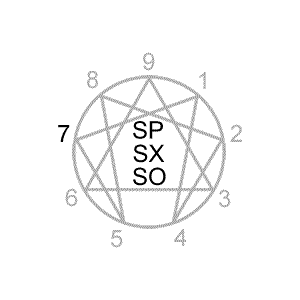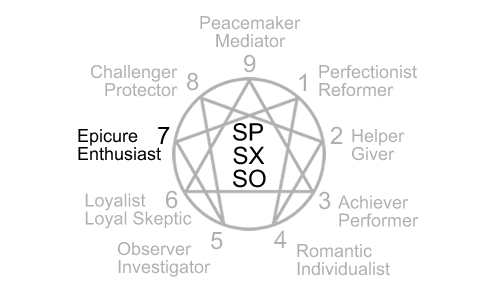Enneagram Type 7 Instinctual Subtypes: SP 7, SX 7, SO 7
The core focus of Enneagram type 7

Follow your bliss and the universe will open doors where there were only walls.
- Joseph Campbell
Early in life we develop an initial belief about ourselves and a compensation for that self-belief.
-
Type 7 Initial Self-Belief: “I am not satisfied as I am.”
Type 7 Compensation: "I must stay open to exciting possibilities that may become available in life and avoid limitations on my pursuits."
Over time this gets generalized beyond the self into a core focus that also shapes how we perceive and interact with the world at large.
-
Type 7 Core Focus: Enthusiasm comes from possibilities that lead to something interesting, exciting, or satisfying. This requires that I anticipate whether a path might lead to something positive or negative. The positives are pursued while the negatives are avoided, reframed, or escaped from.
Personality characteristics that might arise from the type 7 core focus include:
- Likes to keep options open for fear of missing out in life
- Escapes pain and boredom by quickly moving on to something else
- Avoids commitments/obligations that feel limiting and restrictive
- Equalizes relationships with authority to avoid being limited by them
- Attempts to lighten up situations when they become too serious
- Mind quickly jumps between possibilities when excited about an idea
- Lives in anticpation of fun and exciting future possibilities
- Difficulties following through to completion on projects
- Skates on the surface of feelings for fear of getting stuck in them
Enneagram type 7 instinctual subtypes

The Enneagram instincts are self-preservation (sp), sexual (sx), and social (so). The sexual (sx) instinct is also called the intimate or one-to-one instinct.
The instincts are traditionally used to define three instinctual subtypes or variations of a basic type (e.g., SP 7, SX 7, and SO 7). One of these three subtypes is called the counter-type because it can look different from the basic type.
Below are brief descriptions of the three type 7 instinctual subtypes.
SP 7 - Like-Minded, Family:: networks with like-minded people who support self-interests; on the lookout for opportunities that satisfy their interests and needs; finds good justification for behavior in pursuit of self-interests.
SX 7 - Fascination, Suggestibility: lured or pulled by imaginings or fantasies that embellish reality; an optimism of someone who’s in love; can be easily overtaken by enthusiasm and fascination for an ideal.
SO 7 - Sacrifice (counter-type): postpones or defers desires and gratification in favor of pursuing an ideal; moved by duty and recognition toward service of humanity; seeks recognition and applause for being good according to social consensus.
While an individual may be identified with type 7 in general, that same individual may be more specifically identified with one of the three instinctual subtypes as well.
A more recent approach to using the instincts is instinctual variant stacking which can be used independent of Enneagram type.
What Enneagram authors say about type 7 instinctual subtypes

Below are Enneagram 7 subtype description samplings from some popular or well-known Enneagram authors. Click on the sources after the descriptions to further explore these interpretations.
-
In the average range, Self-Preservation Sevens are determined, energetic people, driven to make sure that their basic needs and comforts will always be met.1
In the average range, Sexual Sevens are constantly looking for something new and beyond the ordinary; like Fours, they tend to reject the mundane.1
In the average range, Social Sevens often cultivate a group of friends and "advisors" who share enthusiasms and interests with them.1
-
Family (Like-minded Defenders) as a Self-preservation Tactic: A Seven likes the security of belonging to a group of like-thinking people, who mirror back the Seven’s beliefs.2
Suggestibility (Fascination) in One-to-One Relationships: For Sevens, new experiences and ideas become heightened by positive imagination to the extent that they take on the force of accomplished facts.2
Sacrifice (Martyr) in the Social Arena: Sevens can accept the limitation of options imposed by obligations to others, because they couple it with the belief that all limitations are temporary, and move toward positive future goals.2
-
Self-Preservation Sevens: Are a little confusing since they tend to be highly social. Enjoy operating within their real or chosen family, checking in with a group of like-minded people.3
Intimate Sevens: Tend to garnish and embellish reality with fantasy. Intimate relationships are often thought of as shared experimental adventures, and the Seven perceives their partner through a veil of imagination.3
Social Sevens: Tend to feel responsible for the people around them and experience that as a confining burden. They then react against the weight of obligation, seeking variety and craving change.3
-
Type 7 Instinctual Subtypes by Beatrice Chestnut
Self-Preservation Seven: "Keepers of the Castle"
Expresses gluttony through making alliances and creating opportunities for gaining an advantage. The name "Keepers of the Castle" refers to their way of establishing a partisan network of allies through which they create safety and satisfy their needs.4Sexual Seven: "Suggestibility"
Expresses gluttony through a need to imagine something better than ordinary reality. Gluttons for things of a higher world, they are idealistic dreamers with a passion for living in their imaginations.4Social Seven: "Sacrifice"
Goes against gluttony through conscientious efforts to be of service to others. Conscious of wanting to avoid exploiting others, they have a need to be good and pure and to sacrifice their own needs in supporting the needs of others.4
Sources
1Book: The Wisdom of the Enneagram; Website: The Enneagram Institute
2Book: The Enneagram; Website: The Narrative Enneagram
4Book: The Complete Enneagram; Website: Chestnut Paes Enneagram Academy
To learn more about the instincts click on a link below.
Enneagram Tests to Help Determine Instinct

There are two approaches to using the Enneagram personality instincts.
The instinctual subtypes describe three variations of each of the Enneagram types: a self-preservation (sp), sexual (sx), and social (so) subtype.
Instinctual variant stacking can be used with or without reference to Enneagram type by determining an individual's preferential order for the the three instincts (i.e., sp/sx, sx/sp, sp/so, so/sp, sx/so, or so/sx).
-
Instinctual Subtype Test
This test compares the three instinctual subtypes for a given type.
Use when you know your type and want to find your instinctual subtype for that type. -
Instinctual Variant Stacking Test
This test ranks the three instincts to determine your preferential order of the instincts.
Use when you want to know your instinctual variant stacking independent of type.
To learn more about Enneagram personality type 7 click here.
Click here for the Complete Guide to the Enneagram.
This free guide explains- the nine Enneagram personality types
- the many type variations within type
- where the types came from (origins and history)
- how the types use the Enneagram symbol
Click here for Enneagram tests.
These free tests help you find your- primary type
- candidate types
- preferred wing
- intinctual subtype
- instinctual variant stacking
- center types (gut, heart, and head)
- tri-center with wings